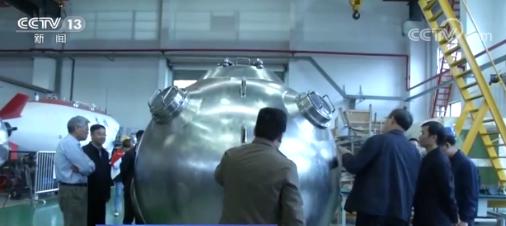

The manned cabin for a new deep-sea manned submersible [Photo/CCTV]
China has developed and completed the manned cabin for a new deep-sea manned submersible capable of carrying three people deeper than 10,000 meters, according to media reports.
Researchers from the Institute of Metal Research at the Chinese Academy of Sciences said Monday that the manned cabin has the largest space and carrying capacity among myriameter (10,000 meters) manned cabins worldwide.
The manned cabin, made of titanium alloy, is the core component of the deep-sea manned submersible, and has recently passed through hydrostatic pressure-test assessments and obtained approvals for the vehicle's integration unit.
There are three observation windows on the spherical shell of the manned cabin – at the front is a main driving window, while the remaining two are for general viewing at both sides.
After the crew enters the cabin from the top, the hatch cover will be closed, making the spherical shell a completely enclosed environment.
The shell is both the cab and only activity space for crew members. With a diameter of less than two meters, the crew can only squat or sit in the cabin.
On completion the submersible will able to plunge deep down into the Mariana Trench in the Pacific Ocean, the deepest trench in the world, and allow China to carry out scientific research in the deepest sea areas.
This, however, is not the first time that China's self-developed submersibles have dived into the deepest trench.
In June 2012, China's first deep-sea manned submersible, Jiaolong, named after a mythical sea dragon, set a world diving record for submersibles of its kind by making it 7,062 meters deep in the Mariana Trench.
This made China the fifth country, after the United States, Russia, France and Japan, to have the ability to send humans deep into the sea. This also meant the country is capable of exploring more than 99.8 percent of the ocean floor.
But China set further goals, dedicating itself to developing a new manned submersible that can reach a depth of 11,000 meters.
Lei Jiafeng, deputy designer of the submersible, said they took three years to complete the construction of the cabin.
"At the beginning of the project, there was not such a material plan globally to build a cabin that can dive into 10,000-meter depths of water," he said.
Despite challenges, they successfully developed the ideal material, titanium alloy, for building the submarine.
"Titanium alloy, also known as marine metal, is resistant to seawater corrosion. It does not report signs of corrosion when it is put in seawater, even after decades," said Lei.
Further work, including the installation and integration of devices in and outside the cabin, is still underway, according to Liu Shuai, general constructor of the submersible.
It is estimated that it will take more than 10 hours for the submersibles to travel to and from the 10,000-meter deep sea and carry out scientific research. All crews will face mental and physical challenges in the voyages undertaken in the claustrophobic environment.
The submersible was built after a second-generation Rainbow Fish reached a depth of more than 10,900 meters last year. Most of its key components were domestically made. (chinadaily.com.cn)

86-10-68597521 (day)
86-10-68597289 (night)

52 Sanlihe Rd., Xicheng District,
Beijing, China (100864)

